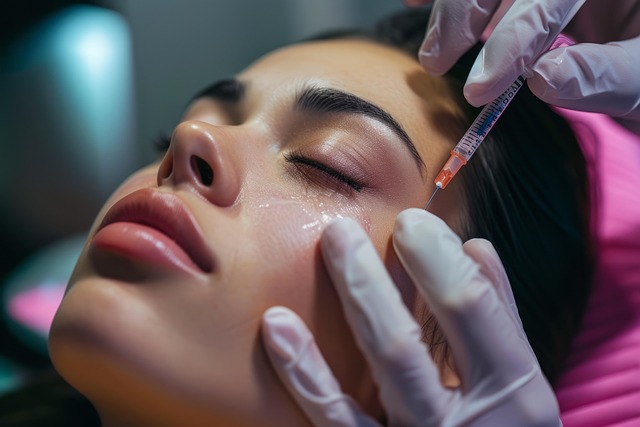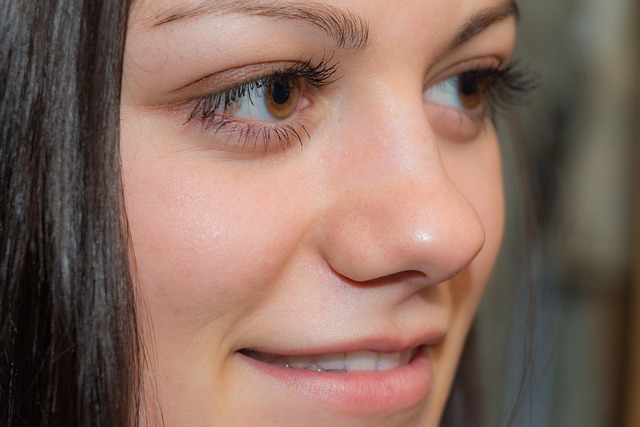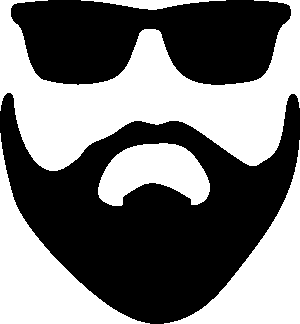Botox for facial contouring is a non-invasive procedure gaining popularity for defining and balancing jawlines, offering minimal downtime and natural results. It temporarily paralyzes muscles responsible for dynamic lines and wrinkles around the jawline and eyes, addressing aging or genetic concerns. Ideal candidates have mild to moderate muscle tightness or squared jawlines they wish to soften; it's not recommended for severe bone structure issues or dramatic changes. The procedure takes 20-30 minutes and results last 3-6 months, requiring touch-up treatments. Post-treatment care involves avoiding strenuous activities and extreme temperatures for 24 hours, using gentle cleansers, and applying cold compresses. Regular maintenance visits every 3-6 months are crucial for sustained results. Botox contouring enhances natural features, reducing jowls and improving facial harmony, making it a preferred method for many seeking non-surgical enhancements.
“Discover the transformative power of professional Jawline Botox for facial contouring. This comprehensive guide delves into the science behind this non-invasive procedure, offering a safe and effective solution for defining jawlines. From understanding the fundamentals of jawline contouring to exploring benefits, candidate selection, and post-treatment care, we cover it all. Learn how Botox can enhance your facial esthetics, with real-life success stories inspiring you to take the next step in your journey towards enhanced confidence.”
Understanding Jawline Contouring with Botox

Many people are turning to Botox for facial contouring, particularly targeting the jawline for a more defined and balanced look. Jawline contouring with Botox involves strategically injecting small amounts of this neurotoxin into specific muscle groups along the jawline. This procedure smooths out jagged lines and contours, creating a sleeker, more angular appearance without surgery.
By relaxing the muscles responsible for biting and chewing, Botox can reduce the prominence of the jawline, enhancing facial balance and proportion. This non-invasive approach to facial contouring is increasingly popular due to its minimal downtime, natural results, and ability to address specific areas of concern related to aging or genetic traits.
The Science Behind Botox for Facial Esthetics

The science behind Botox for facial esthetics is grounded in its ability to temporarily paralyze or weaken specific muscle groups, leading to a reduction in dynamic lines and wrinkles. When administered by a professional, Botox injects into the muscles responsible for frowning, squinting, or biting, thereby smoothing out the skin’s surface. This non-surgical approach to facial contouring offers a natural-looking result, enhancing one’s features rather than altering them drastically.
The mechanism of action involves botulinum toxin, a protein produced by bacteria, which disrupts nerve signals to the muscles, preventing them from contracting. As a result, over time, these muscles lose their ability to create repetitive movements that contribute to the formation of fine lines and deep wrinkles, particularly around the jawline and eyes. This procedure is increasingly popular for those seeking subtle yet effective facial contouring, offering both immediate and long-lasting results.
Benefits of Using Botox for Jawline Shaping

Botox has emerged as a popular and minimally invasive method for facial contouring, offering several advantages for those seeking to enhance their jawline and overall facial aesthetics. One of its key benefits is the ability to reduce the appearance of a square or angular jaw by relaxing the muscles responsible for excess tension and defining the jawline’s curve. This non-surgical procedure provides a natural-looking result, smoothing out the skin without any significant downtime or recovery period, which sets it apart from more aggressive cosmetic surgeries.
Additionally, Botox for facial contouring can help alleviate symptoms of bruxism (teeth grinding) and temporomandibular joint disorder (TMJ). By reducing muscle activity in the jaw area, it may prevent headaches, facial pain, and other discomforts associated with these conditions. The precision of Botox injections allows for targeted treatment, making it an attractive option for individuals looking to refine their facial features without extensive surgery.
Candidate Selection: Who is a Good Fit?

When considering Botox for facial contouring, understanding candidate selection is key. The ideal candidate for jawline Botox treatment is someone who has mild to moderate muscle tightness or a squared jawline they wish to soften. This procedure is not suitable for individuals with severe bone structure issues or those looking for dramatic changes.
It’s important to note that Botox works best on patients with good skin elasticity and those committed to regular follow-up sessions. During the consultation, a qualified healthcare provider will assess your specific concerns, medical history, and facial anatomy to determine if you’re a good fit for jawline Botox.
Procedure Overview: What to Expect During Treatment

The procedure for professional jawline Botox facial contouring involves a meticulous approach to enhance facial aesthetics. During treatment, a skilled provider will carefully inject small amounts of Botox into specific muscles along the jawline and cheek area. This targeted technique relaxes the muscles, reducing the appearance of jaw tension and unwanted facial lines. Patients can expect a relatively quick procedure, typically lasting around 20-30 minutes, with minimal discomfort.
As the Botox takes effect over the next few days, you’ll start to notice a subtler, more balanced look. The treatment aims to smooth out rough jawlines and reduce the depth of facial wrinkles, providing a refined and natural-looking result. It’s important to discuss your expectations and medical history with the practitioner to ensure optimal outcomes and address any potential side effects.
Safety and Potential Side Effects

When considering jawline botox for facial contouring, safety should always be your top priority. Botox is a highly safe and effective treatment when administered by qualified professionals. However, like any medical procedure, it’s not entirely free of potential side effects. Temporary redness, swelling, or bruising at the injection site are common, but usually subside within a few days. In rare cases, patients may experience muscle weakness in the treated area, affecting jaw movement or even causing difficulty chewing.
Another important consideration is allergic reactions, though these are extremely uncommon with Botox injections. It’s crucial to inform your provider about any allergies you have before the procedure. Additionally, while botox for facial contouring can significantly enhance facial aesthetics, it’s not a permanent solution. Effects typically last between 3 to 6 months, after which touch-up treatments may be needed to maintain the desired jawline definition.
Optimizing Results: Post-Treatment Care

After receiving professional jawline Botox for facial contouring, proper post-treatment care is essential to optimize results and ensure a smooth recovery. It’s crucial to avoid strenuous activities and extreme temperatures (hot or cold) for at least 24 hours following the procedure. This includes steering clear of saunas, steam rooms, or intense workouts that could cause blood flow to increase in the treated area, potentially impacting the effectiveness of Botox.
Additionally, while it’s normal to experience some mild swelling or bruising, keeping the treated area clean and protected is vital. Refrain from touching or rubbing the jawline, and use a gentle cleanser recommended by your dermatologist. Applying cold compresses can help reduce any post-procedure inflammation, but remember not to apply ice directly onto the skin—a thin towel between the ice pack and your face is best. Staying hydrated and getting ample rest will also aid in the healing process.
Maintenance and Follow-Up Visits

After your initial Jawline Botox treatment, maintenance and follow-up visits are crucial for optimal results. These appointments allow your provider to assess the progress of the procedure and make any necessary adjustments to maintain natural-looking facial contouring. Since Botox is a temporary solution, regular touch-ups every 3-6 months are typically recommended to prevent the return of excess jutting jawline or neck bands, ensuring you achieve long-lasting, yet subtle enhancements.
During follow-up visits, your provider will discuss any concerns or changes in your facial structure and tailor the treatment plan accordingly. These visits also offer an opportunity to stay informed about new advancements in Botox for facial contouring, ensuring you receive the most effective and modern techniques available.
Real-Life Success Stories: Transformations with Botox

In the world of aesthetic advancements, Botox for facial contouring has emerged as a popular and effective treatment. Real-life success stories abound, with individuals sharing their transformative journeys. Many have witnessed significant improvements in their facial appearance, particularly in defining jawlines and reducing the appearance of jowls. These treatments offer a non-invasive approach to achieving a more youthful and chiseled look without the need for surgery.
Through Botox injections, professionals can target specific muscle groups responsible for skin drooping and sagging. The results are often subtle yet remarkable, providing patients with a more balanced and contoured facial profile. Such success stories have fostered a growing interest in this procedure, as folks seek ways to enhance their natural features and regain confidence in their appearance.
